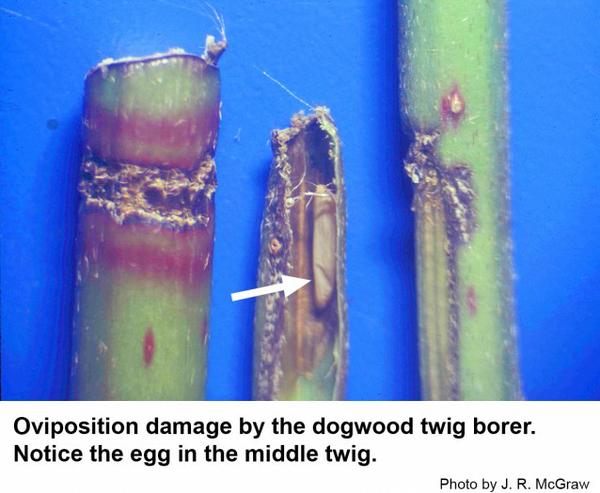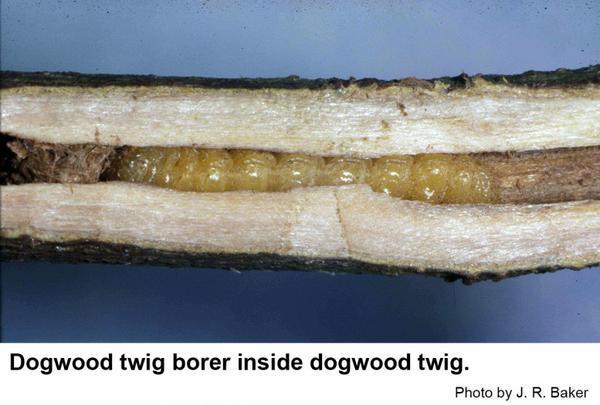Description and Biology
The dogwood twig borer, Oberea tripunctata, is a 1/2 to 5/8 inch long, slender, longhorned beetle that emerges from damaged dogwoods in late spring after the new vegetative growth has matured somewhat. These beetles fly to the new growth and chew a series of holes around the stem and then another series of holes one forth to half an inch away. Between these rows of holes the beetles insert an 1/8 inch long egg into the bark. Within a few weeks this egg matures and a slender, white grub hatches and begins to feed within the stem. As the grub bores downward, the stem dies and wilts above the area girdled by the beetle. The larvae bore downward and sawdust and other waste products are pushed out of holes along the stem. The grub eventually grows to about 7/8 inch long and overwinters in a cell excavated inside the twig. The following spring the grub matures and molts into a pupal stage. A few weeks later, a new generation of beetles emerges from infested plants to continue the life cycle.
Host Plants
This pest is also know as the elm twig girdler. Elm, viburnum, azalea, and many fruit trees may be attacked by the dogwood twig borer, though its principal host is flowering dogwood. Infested branches often die or they are so weakened that they break off easily.
Residential Recommendation
For control of dogwood twig borers, the plants can be sprayed in late spring with a pyrethroid insecticide to prevent the new generation of beetles from laying eggs. When used as directed, pyrethroids are very toxic to insects but are not particularly hazardous to humans and pets (other than fish-avoid using pyrethroids around pools, ponds, and streams). Infested stems can be pruned out as soon as wilting is noticed in early summer. Be sure to prune below the grub! These stems should be burned or otherwise destroyed to prevent the beetle grubs from surviving to produce more beetles next year. Fortunately, the dogwood twig borer is a sporadic pest so that treatment is probably not needed every year.
References
- Guide to Insect Boreres in North American Broadleaf Trees and Shrubs. Solomon, J. D. USDA Forest Service Agriculture Handbook AH-706. 747 pp.
- Insect and Related Pests of Shrubs. Baker, J. R. ed. 1980. NC Agricultural Extension Service publication AG-189. 199 pp.
- Dogwood Pest Management Calendar. Frank S. and J. R. Baker. 2019. Entomology Insect Notes, NC State Extension Publications.
- Dogwood Twig Borer. Day, E. R. 2020 revision. Virginia Tech, Virginia Coop. Extension. Entomology Pub. 444-625.
- Extension Plant Pathology Publications and Factsheets
- Horticultural Science Publications
- North Carolina Agricultural Chemicals Manual
For assistance with a specific problem, contact your local N.C. Cooperative Extension Center.
This Factsheet has not been peer reviewed.
Publication date: Nov. 18, 2013
Reviewed/Revised: Nov. 3, 2023
Recommendations for the use of agricultural chemicals are included in this publication as a convenience to the reader. The use of brand names and any mention or listing of commercial products or services in this publication does not imply endorsement by NC State University or N.C. A&T State University nor discrimination against similar products or services not mentioned. Individuals who use agricultural chemicals are responsible for ensuring that the intended use complies with current regulations and conforms to the product label. Be sure to obtain current information about usage regulations and examine a current product label before applying any chemical. For assistance, contact your local N.C. Cooperative Extension county center.
N.C. Cooperative Extension prohibits discrimination and harassment regardless of age, color, disability, family and marital status, gender identity, national origin, political beliefs, race, religion, sex (including pregnancy), sexual orientation and veteran status.




